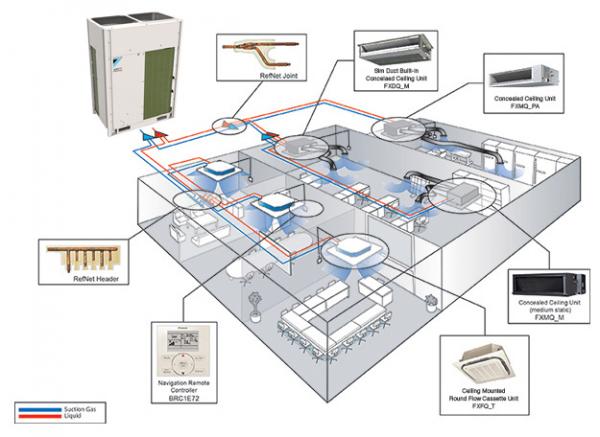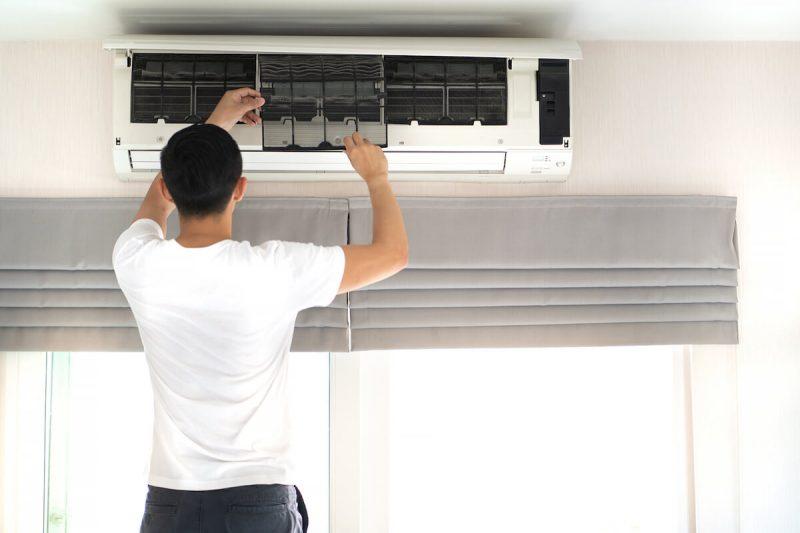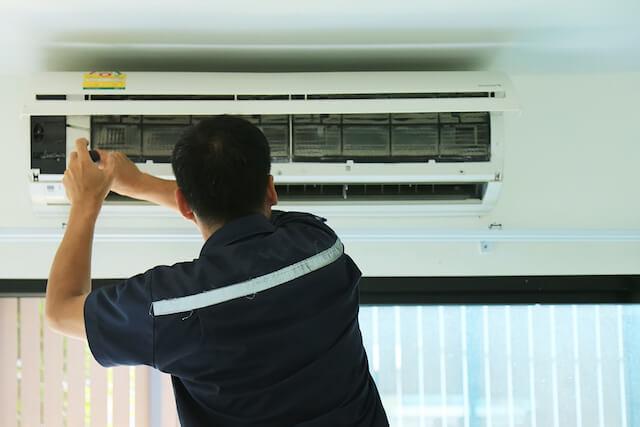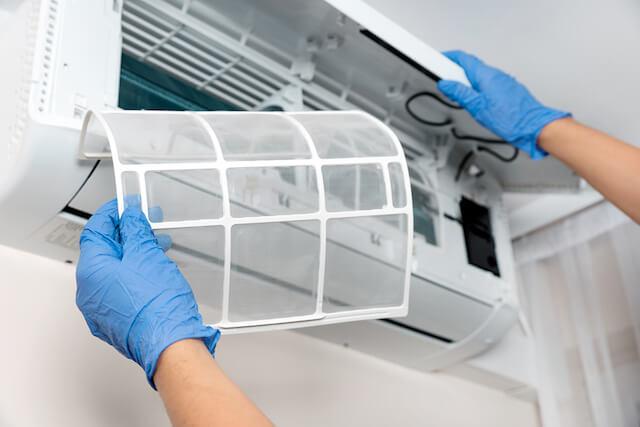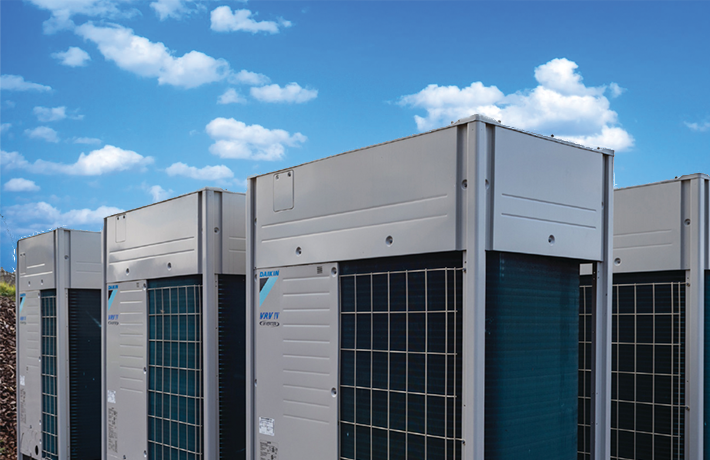
In Singapore, air conditioning is part of everyday life. With the island’s tropical climate, humidity levels remain above 70 per cent most of the year, and daytime temperatures rarely dip below 30°C. For homeowners and businesses alike, cooling is a necessity that helps them combat the often-brutal heat.
However, this comfort comes at a cost. Rising electricity tariffs and increasing energy costs in Singapore mean households, offices, and hotels are now paying closer attention to the systems they choose. The demand is not only for comfort but also for efficiency, reliability, and long-term sustainability.
Traditionally, many spaces have relied on inverter multi-split systems. While these are more efficient than older fixed-speed compressors, they still have limitations, particularly when it comes to energy distribution across multiple rooms or zones. This is where VRV and VRF systems could present a modern alternative.
Known for their advanced cooling technology, VRV and VRF systems offer precise zoning, better efficiency, and scalability for both small residences and large commercial properties. They are fast becoming the benchmark for modern cooling solutions in Singapore. In this article, we will delve into what these sys
Key Takeaways
- Precision and savings: VRV and VRF air-conditioning systems reduce wasted energy by cooling only occupied zones, directly addressing rising energy costs in Singapore.
- Flexible applications: These systems are suitable for condos, landed homes, offices, retail outlets, hotels, and even industrial facilities.
- Compliance and confidence: It is advisable to work with a certified aircon contractor who can ensure that the system is properly installed in line with NEA efficiency standards.
Why VRV and VRF Systems Are Changing the Cooling Landscape in Singapore
What Makes VRV and VRF Systems Different
The terms VRV aircon and VRF aircon are often used interchangeably, but they both refer to the same principle: precision cooling through advanced refrigerant control. Daikin, being the original inventor, trademarked the name VRV (Variable Refrigerant Volume) , while VRF (Variable Refrigerant Flow) became the generic term adopted by other manufacturers. Regardless of branding, both technologies work in exactly the same way.
Traditional inverter multi-split systems improve on old fixed-speed compressors by adjusting motor speeds, but they still send refrigerant to all connected indoor units, even if certain rooms are unoccupied. This leads to energy inefficiencies, particularly in larger homes, offices, or hotels where not every space requires cooling at the same time.
By contrast, VRV and VRF systems intelligently regulate the exact volume of refrigerant sent to each indoor unit, ensuring that cooling is delivered only where it is needed. This zoning capability means that one bedroom, a conference room, or a retail space can be cooled independently without affecting other areas. The result is optimised efficiency, lower energy bills, and enhanced comfort across multiple zones. For Singapore’s climate, where cooling is a year-round demand, this precise approach offers both practical and financial advantages.
Tackling Energy Costs in Singapore
With electricity tariffs rising over the years, Singaporeans are increasingly conscious of how much it costs to stay cool. Air conditioning often makes up the largest share of household and commercial utility bills.
VRV and VRF systems address this issue by:
- Reducing unnecessary energy use in unoccupied rooms.
- Maintaining high part-load efficiency when only a few zones are active
- Offering flexibility in scheduling and zoning to align with real usage patterns.
Over a 10-year period, a building using this system can save tens of thousands of dollars compared to one using inverter multi-split systems.
Indoor Unit Options and Aesthetic Integration
One of the greatest assets of VRV and VRF systems is their compatibility with different types of indoor units:
- Wall-mounted units: Compact and affordable, making them ideal for smaller spaces like bedrooms or compact offices. n
- Ceiling cassette units: Discreet and effective, blending seamlessly into false ceilings with 360-degree airflow.
- Ceiling-suspended units: Strong airflow capacity, often used in restaurants, classrooms, or open spaces.
- Ducted concealed units: Premium and virtually invisible, popular in luxury condos, hotels, and high-end offices.
This range of possible applications that these systems offer ensures that property owners do not have to compromise between comfort, performance, and design.
Applications Across Property Types
- Residential: Condos in areas such as Orchard and Marina Bay often use VRV and VRF systems to cool multiple rooms discreetly whilst adhering to façade restrictions. Landed homes in Bukit Timah and Sentosa Cove benefit from long piping runs and ducted indoor units for a clutter-free aesthetic. n
- Commercial: Many offices in the CBD area, including Raffles Place and Shenton Way, benefit significantly from independent cooling for meeting rooms, server rooms, and open-plan areas.
- Retail: Several shopping malls, like VivoCity or those found along Orchard Road also use zoning to save energy during off-peak hours.
- Hospitality: High-end hotels like Marina Bay Sands allow individual room temperature control without compromising common areas like lobbies or corridors.
- Industrial: Factories in Jurong and research facilities in Science Park require different cooling for labs, storage zones, and production floors, which VRF aircons are able to handle with precision.
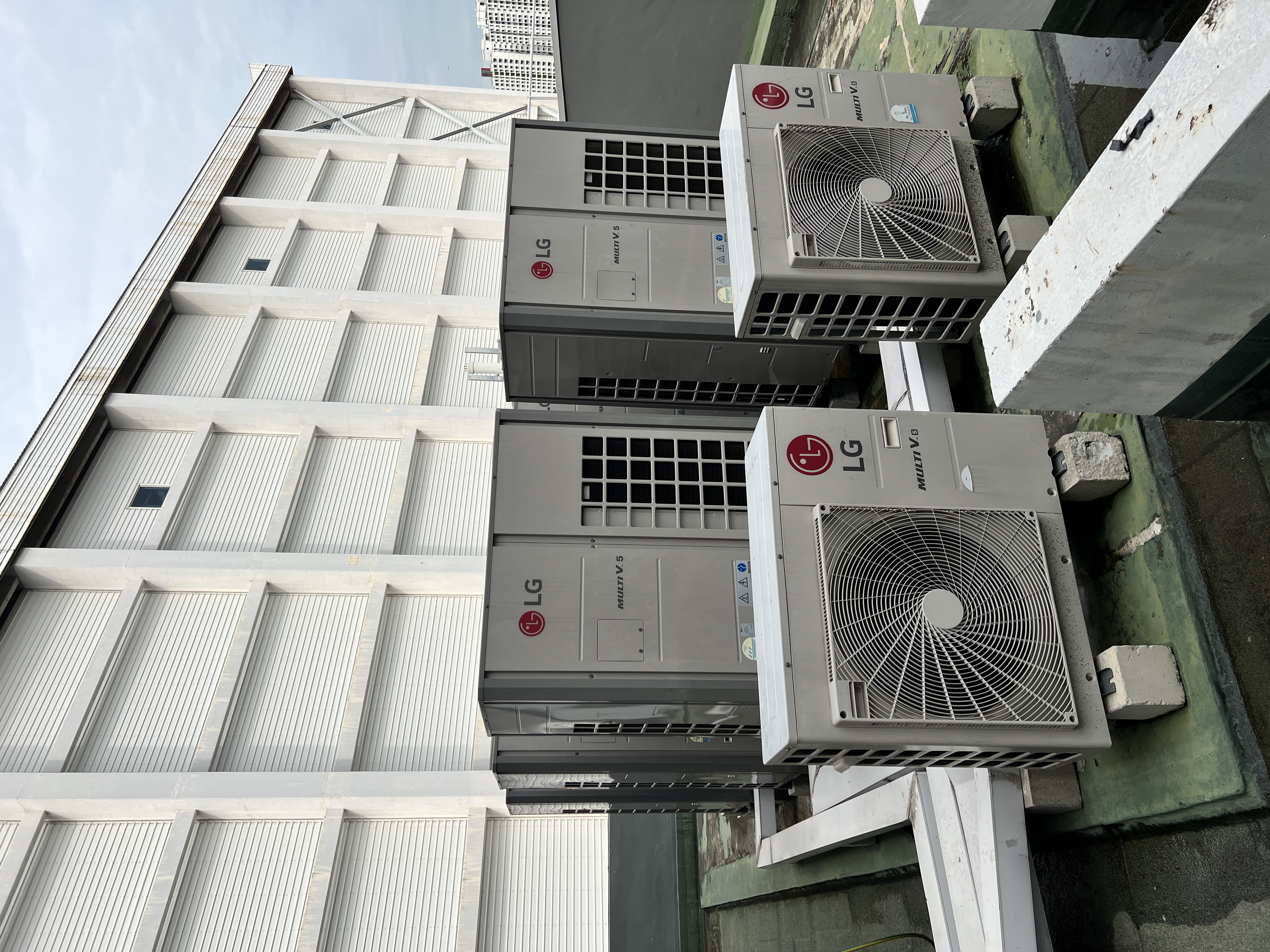
Compliance with NEA Efficiency Standards
Air conditioning in Singapore is not only about comfort but also about meeting strict regulatory standards that safeguard energy efficiency, safety, and sustainability. VRV and VRF systems are designed to align with these requirements, making them an ideal choice for residential, commercial, and industrial projects
NEA Efficiency Standards
The National Environment Agency (NEA) enforces mandatory energy labelling and compliance with the Minimum Energy Performance Standards (MEPS) . These requirements ensure air conditioning systems operate at acceptable efficiency levels. Thanks to their zoning flexibility, part-load efficiency, and advanced control features, VRV and VRF systems often achieve higher Energy Efficiency Ratios (EERs) than conventional systems, exceeding NEA efficiency benchmarks.
BCA Regulations
The Building and Construction Authority (BCA) sets guidelines covering safe installation practices. This includes:
- Proper handling of pipe penetrations through structural walls.
- Correct design for drainage and condensate discharge.
- Fire safety clearance for ducting and piping that pass through fire-rated areas.
Airple, as a BCA-certified aircon company, ensures that every project complies with these standards. This reduces approval delays and guarantees safety across residential and commercial installations.
BCA Green Mark Certification
Sustainability is a national priority in Singapore, and many developers aim for BCA Green Mark certification as proof of environmentally responsible building design. VRV and VRF systems support this by:
- Reducing total cooling loads through intelligent zoning.
- Allowing scheduling to match real occupancy patterns.
- Supporting integration with smart building management systems.
These features contribute directly to higher Green Mark scores and long-term energy savings.
MCST & Landlord Approvals
In condominiums and commercial towers, MCSTs and landlords often require formal approval before installations proceed. Typically, submissions must include:
- Pipe routes and proposed pathways.
- Outdoor unit placement and its impact on the building façade.
- Noise control measures for both indoor and outdoor units.
Airple assists clients by preparing method statements and technical documents to secure approvals, ensuring that projects move forward smoothly.
By meeting NEA efficiency standards, adhering to BCA regulations, supporting Green Mark certification, and handling MCST or landlord approvals, property owners not only stay compliant but also gain long-term cost savings, sustainable performance, and peace of mind.
Installation, Costs, and Maintenance of VRV and VRF Systems
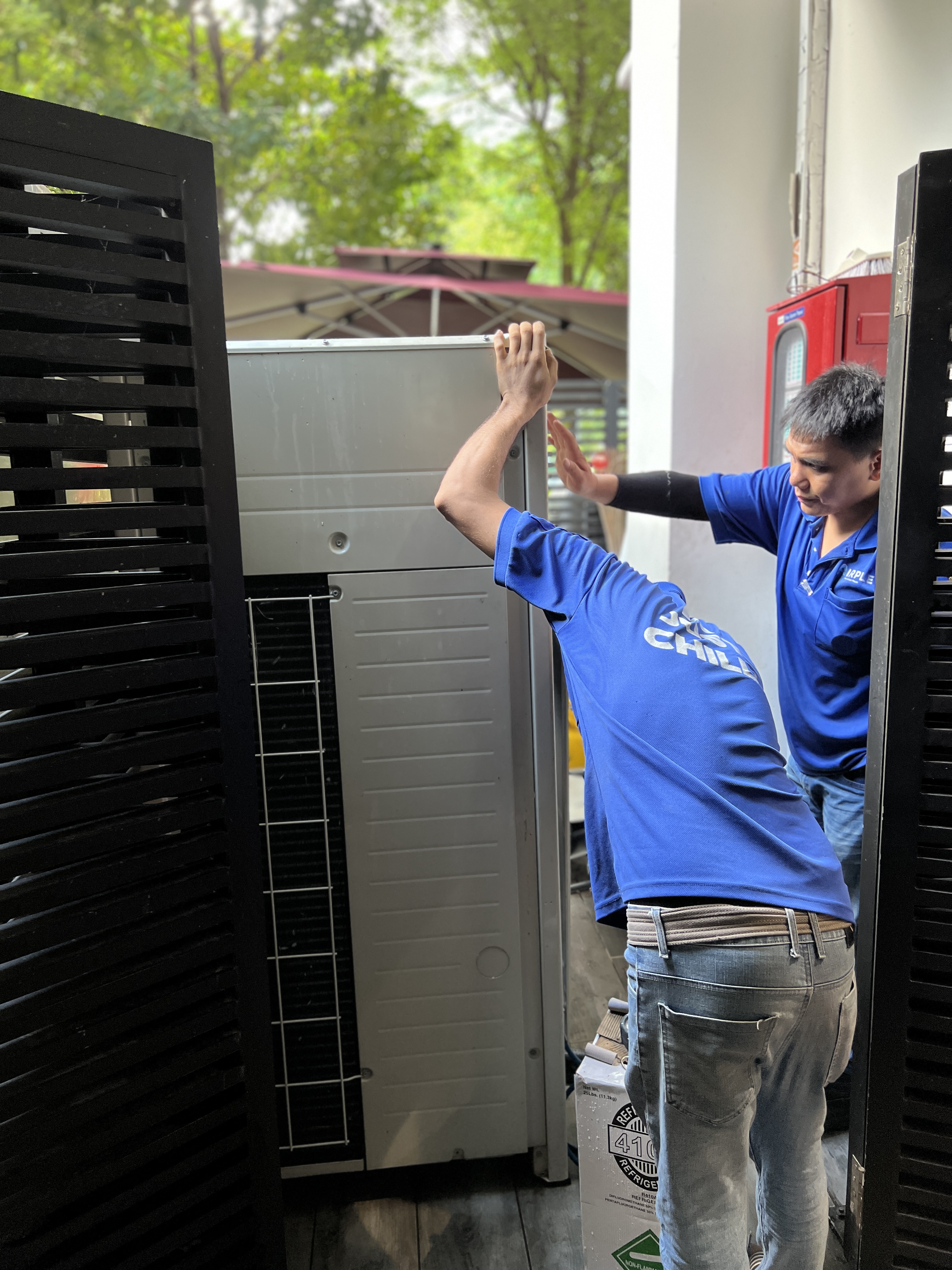
Unlike standard split systems, VRV and VRF systems require careful planning and execution. At Airple, our aircon contractors approach every installation as an engineering project, prioritising safety, compliance, and long-term durability from start to finish.
-
1. Site Inspection & Design
- Load Analysis: Every room’s cooling requirement is carefully calculated.
- Crane & Access Planning: Outdoor units may need to be lifted to rooftops. We calculate lifting radius, truck tonnage, and set up exclusion zones to protect pedestrians and traffic.
- Structural Adjustments: In some cases, piping must pass through non-load-bearing walls, or walls may be rerouted to accommodate pipework.
- Pipe Routing: We balance the shortest piping distance with ease of maintenance and aesthetics, ensuring condensate drains are correctly angled to avoid backflow.
-
2. Refrigerant Distribution: Y-Joints vs Branch Boxes
- Y-Joints: Simple split fittings used in smaller projects with straightforward zoning. They are cost-effective but less flexible.
- Branch Boxes: Distribution hubs that manage multiple indoor units, ideal for larger or more complex projects. They allow independent zone control and make maintenance easier since specific areas can be isolated.
- Rule of Thumb: Y-joints are ideal for simple homes, while branch boxes are recommended for offices, hotels, or large condos with multiple zones.
-
3. Piping, Insulation & Jacketing
- Standard Insulation: Foam or rubber insulation prevents condensation and is suitable for most indoor runs.
- Jacketing: Aluminium, PVC, or stainless steel casings are applied over insulation to protect outdoor runs from UV and rain. In coastal areas like Sentosa, jacketing is critical to prevent salt-air corrosion. It also provides a neater, premium finish for high-end properties.
-
4. Testing & Commissioning
- Pressure Tests: Ensure there are no refrigerant leaks.
- Vacuuming: Removes air and moisture from the system.
- Refrigerant Charging: Precision filling for optimal efficiency.
- Balancing: Guarantees that each indoor unit receives the correct refrigerant flow.
- Handover: Includes client training, full documentation, and a scheduled maintenance plan.
With BCA and WSH certification, Airple guarantees that every installation meets Singapore’s strict safety and building standards, giving clients peace of mind.
Cost Ranges and Return on Investment
The cost of VRV and VRF systems varies depending on the scope of the project:
- Small projects (double-fan units): S$8,000–S$12,000.
- Medium projects: S$15,000–S$30,000+, depending on the zoning.
- Large developments: S$50,000 or more. This typically includes hotels, malls, and industrial facilities.
Although upfront costs are higher than those of inverter multi-split systems, the long-term savings make these systems a financially sound investment. With better efficiency, fewer outdoor units, and longer system lifespans , property owners benefit significantly over time.
Here is a 10-year cost comparison:
| Item | Inverter Multi-Split | VRV VRF System |
|---|---|---|
| Upfront Cost | S$8,000 | S$15,000 |
| Average Annual Electricity | S$6,000 | S$4,200 |
| 10-Year Electricity Cost | S$60,000 | S$42,000 |
| Total 10-Year Cost | S$68,000 | S$57,000 |
| Savings | - | S$11,000 |
In the long run, VRV and VRF systems can save property owners at least S$11,000 over 10 years in electricity alone. This does not even factor in reduced maintenance costs, longer system lifespans (15–20 years), or the potential boost in property value.
Servicing and Preventive Care
Like all complex machinery, VRV and VRF systems need regular aircon servicing . Tasks include:
- Cleaning and filter replacement.
- Refrigerant pressure checks and top-ups.
- Inspection of Y-joints and branch boxes.
- Condensate drain flushing.
- Diagnostics for irregularities in refrigerant flow or compressor operation.
Air conditioners are not immune to issues either. Here are some common problems and how Airple can resolve them:
-
Condensation Leaks
- Cause: Poor insulation or damaged cladding, leading to water dripping from indoor units.
- Airple’s fix: Apply the correct insulation thickness, add jacketing for outdoor piping, and ensure that condensate drains are installed with the proper fall to prevent backflow.
-
Refrigerant Leaks
- Cause: Poor brazing techniques or low-quality fittings.
- Airple’s fix: All brazing work is carried out by trained technicians, using nitrogen purging during welding to protect pipe integrity and prevent leaks.
-
Noise & Vibration
- Cause: Piping in contact with structures or improper mounting of units.
- Airple’s fix: Use vibration isolation, proper pipe brackets, and acoustic insulation to reduce noise and maintain a quiet, comfortable environment.
-
Inaccessible Branch Boxes
- Cause: Incorrect placement of branch boxes within hard-to-reach ceiling voids, making future servicing difficult.
- Airple’s fix: Careful planning during installation ensures branch boxes are placed with maintenance access in mind, avoiding costly rework later.
Preventive maintenance not only improves efficiency but also protects your investment. By addressing potential issues early, Airple helps ensure that your VRV and VRF systems operate reliably, reducing costly downtime and extending the system’s lifespan.
Leading Brands Available in Singapore
When considering VRV and VRF systems, the choice of brand plays an important role in long-term reliability, efficiency, and after-sales support.
- Daikin (VRV): Pioneer in the field, offering a mature ecosystem and reliable service support.
- Mitsubishi Electric: Known for quiet operation and durability.
- Toshiba: Provides strong efficiency at competitive prices.
- LG: Compact designs with smart technology integration.
- Midea: Offers cost-effective solutions with energy-efficient performance and user-friendly controls.
Regardless of brand, the success of a VRV and VRF system depends on proper design, installation, and servicing by a professional aircon contractor.
Frequently Asked Questions About VRV and VRF Systems
-
What is the difference between VRV and VRF?
They are the same technology. VRV (Variable Refrigerant Volume) is Daikin’s trademark, while VRF (Variable Refrigerant Flow) is the general industry term used by other brands.
-
Are VRV and VRF systems suitable for HDB flats?
No. These systems are best suited for condos, landed homes, offices, hotels, and large commercial or industrial spaces.
-
How much do VRV and VRF systems cost in Singapore?
Costs vary depending on project scale. Small projects start at S$8,000–S$12,000, medium projects range from S$15,000–S$30,000, and large-scale developments such as hotels or factories may exceed S$50,000.
-
Why are VRV and VRF systems more efficient than inverter multi-split systems?
Unlike inverter multi-split systems, which distribute refrigerant across all indoor units whether they are in use or not, VRV and VRF systems regulate both compressor speed and refrigerant flow. This ensures that only the occupied rooms are cooled, significantly reducing energy waste.
-
Do VRV and VRF systems save money in the long run?
Yes. They typically provide 30-40 per cent energy savings, require fewer outdoor units, and last longer. Over a 10-year period, they can save property owners tens of thousands in energy and maintenance costs.
-
What does “heat recovery” mean in Singapore?
Globally, heat recovery means cooling one room while heating another. In Singapore’s tropical climate, it refers instead to load balancing—redistributing refrigerant so high-demand areas (like server rooms or kitchens) do not overburden the system while lighter-load zones remain stable.
-
How often should I schedule servicing?
Servicing should be carried out every three to six months, depending on usage. Offices and hotels with high demand may require more frequent checks.
-
How long do VRV and VRF systems last?
With proper servicing, these systems can last between 15 and 20 years, longer than most standard split systems.
-
What happens if one indoor unit fails?
If one indoor unit malfunctions, the others continue to operate normally. The entire system does not shut down.
-
Are VRV and VRF systems noisy?
No. Both indoor and outdoor units are engineered to operate quietly, making them suitable for residential, commercial, and hospitality environments.
-
Do VRV and VRF systems contribute to BCA Green Mark certification?
Yes. Their zoning efficiency and energy savings directly support BCA Green Mark objectives by lowering overall building cooling loads.
-
Which brand is best in Singapore?
Daikin is the pioneer and offers the most comprehensive ecosystem, but Mitsubishi, Toshiba, and LG also provide reliable and efficient options. The best choice depends on your project needs, budget, and property type.
-
Does Airple assist with MCST submissions?
Yes. Airple helps prepare method statements, technical drawings, and documentation needed for MCST and landlord approvals.
-
Can VRV and VRF systems work with ducted indoor units?
Yes. Ducted concealed units are fully compatible with VRV and VRF systems, making them ideal for premium interiors where aesthetics are a priority.
-
What are Y-joints and branch boxes?
Y-joints are simple fittings that split refrigerant lines, used in smaller projects. Branch boxes are distribution hubs that manage multiple indoor units and are better suited for larger projects with many zones.
-
Why is jacketing recommended for outdoor piping?
While insulation is enough for most indoor runs, jacketing is essential outdoors to protect against UV rays, rain, and salt corrosion (especially in coastal areas like Sentosa). It also improves durability and appearance.
-
How efficient are VRV and VRF systems at part-load operation?
They remain highly efficient even when only a few rooms are cooled, unlike many other systems that waste energy during low-demand periods.
-
What is the typical payback period?
The payback period is usually five to eight years, depending on electricity usage, building type, and prevailing electricity tariffs.
-
Do VRV and VRF systems require specialised technicians?
Yes. Their installation and maintenance are more complex than split systems. Always engage a BCA- and WSH-certified aircon contractor such as Airple.
-
Can VRV and VRF systems improve property value?
Yes. Energy-efficient systems with lower running costs and premium comfort features enhance the attractiveness of residential and commercial properties, boosting resale value.
VRV and VRF systems are changing the way air conditioning is being set up and managed in different spaces. Featuring advanced cooling technology with precision zoning, flexibility, and compliance with NEA efficiency standards, VRV and VRF systems are a smart and sustainable solution for property owners concerned about rising electricity tariffs and energy costs in Singapore.
From residential condos to luxury hotels and high-performance commercial spaces, these systems are built to deliver long-term comfort and savings whilst remaining faithful to sustainable practices.
At Airple, we are more than an aircon company. As a BCA- and WSH-certified aircon contractor, we bring technical expertise, regulatory compliance, and customer-focused service to every project. Our team specialises in aircon servicing , aircon cleaning, and VRV and VRF system installations that will last for decades.
For more information about our services and how we can future-proof your air conditioning setup, please contact us today.
Sign up for our newsletter
Get the best content on user insights, design, and product management delivered to your inbox every week.
Share This Article
